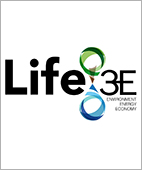
LIFE Project: LIFE-3E - Environment-Energy-Economy
- Type Project
- Status In progress
- Execution 2020 -2025
- Assigned Budget 1.732.084,00 €
- Scope Europeo
- Autonomous community Cantabria
- Main source of financing LIFE
- Project website Web del proyecto
The LIFE-3E project aims to demonstrate the technical, economic and environmental viability of an innovative and efficient process for recovering treated wastewater in coastal areas, with integrated salt gradient energy recovery (SGE), which contributes to improving the sustainability of water resources through the efficient remediation of wastewater in coastal WWTPs, for urban, irrigation or industrial uses.
European policies emphasize environmental protection, resulting in stricter standards for wastewater treatment while encouraging water reuse. In this regard, implementing treated water recovery strategies in urban wastewater treatment plants (WWTPs) can greatly alleviate pressure on freshwater resources while reducing wastewater discharges and their environmental impacts. There are more than 28,000 WWTPs in the European Union, treating over 44.7 billion m3 of wastewater annually, but only 964 million m3 of this treated wastewater is reused. In this context, Europe could increase its reuse rates sixfold. Coastal WWTPs offer the potential to link WWTP effluent and seawater to harness salinity gradient energy (SGE). Water recovered in this way can meet legal standards for reuse while promoting additional benefits, such as reduced exploitation of natural water resources and minimizing the environmental impact associated with marine wastewater discharge. This strategy is aligned with the principles of the Water Framework Directive (WFD) and other EU policies related to renewable energy and the environment.
- Design of processes for wastewater remediation and reuse. Within the legal framework of the DMA, the pilot plant defined in the project could recover more than 24 m3/day.
- Pilot-scale demonstration of the feasibility of converting SGE into electricity by contacting seawater with remediated water, to generate 1.6 W/m2 per cubic meter of treated water using reverse electrodialysis (RED)-SGE technology.
- Systems integration in wastewater treatment plants and optimization to maximize the environmental and socioeconomic benefits of the LIFE-3E approach.
- Assessment of the environmental and economic impact of the application of RED-SGE in WWTPs using LCA/LCC tools.
- Reduction of the CO2 footprint associated with the energy consumed in water recovery at WWTPs.
- Maximizing project results through communication and dissemination.
On-site electricity generated from SGE-type renewable energy will reduce:
- i) the supply of external energy to the WWTP (from 25% for tertiary treatment),
- ii) associated greenhouse gas (GHG) emissions (from 1.2% onwards). The RED-SGE is expected to achieve a 90% GHG reduction compared to conventional energy resources.
Environmental indicators, primarily global warming potential (GWP), will be reduced by renewable energy resources:
- i) reduction of energy based on fossil fuels (0.278 kgCO2-eq./kWh avoided),
- ii) reduction of water extraction for urban uses.
Design, construction, and operation of a RED-SGE prototype to generate electricity from the salinity gradient in a coastal WWTP, taking advantage of the proximity of seawater with the technical objective of generating 1.6 W/m3 of treated water.
Reduction in treatment requirements at the drinking water treatment plant as a result of water reuse, thereby reducing chemical use and sludge generation by 2%.
- Coordinator/entity name: María Sainz
Postal address: B La Barquera, n 13, 39311, Cartes,
The project's solution for more environmentally friendly water treatment contributes to the implementation of the EU Water Framework Directive (2000/60/EC), the Marine Strategy Framework Directive (2008/56/EC), the 2020 Biodiversity Strategy, the revised Renewable Energy Directive (2018/2001/EU), and the Regulation on Minimum Requirements for Water Reuse (EU 2020/741). By reducing CO2 emissions at WWTPs, the project is also in line with the EU 2020 climate and energy package.
- Centro de Investigación del Medio Ambiente,Medio Ambiente, Agua, Residuos y Energía de Cantabria S.A., M.P
- Technische Universität Darmstadt
- APRIA Systems S.L.
- Universidad de Cantabria







